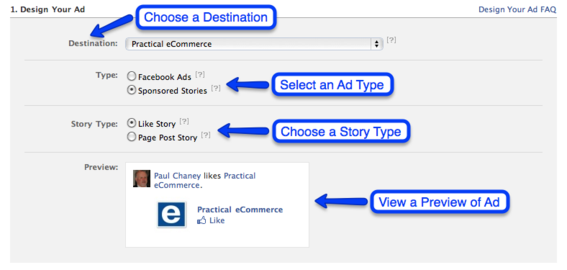Editor’s Note: This is “Part 3” of a three-part series describing the recent changes Facebook made to its platform, and how those changes affect smaller companies. The series has ran in the following order.
In this “Part 3” installment, our own social media guru, Paul Chaney, describes the expansion of Sponsored Stories ad units.
A recommendation from a friend is one of the most powerful forms of advertising a merchant could ask for. It works because it is a referral from a trusted source. Facebook is attempting to turn such referrals into advertising through “Sponsored Stories,” which Facebook explains in its Help Center.
When a Facebook user interacts with a merchant’s fan page — with a “Like,” for example — that activity appears in the user’s News Feed. However, due to the transitory nature of the News Feed and how quickly information is updated, the likelihood of the user’s Friends seeing it is minimal. Sponsored Stories allows the owner of a Facebook Page to call attention to that activity in the form of an advertisement — called a “story” — that appears in the right-hand column of a friend’s profile pages. In other words, what may have passed by too quickly to be seen in the News Feed retains a degree of permanence in the right-hand column and is, therefore, more likely to be seen and acted upon by others.
Sponsored Stories are not only designed to be used with Facebook Pages, but with Facebook Places — a feature that lets users “check in” to a location on their mobile phones — and custom applications, too. And the term “Story” is a little confusing because — in the case of a merchant and a consumer — it’s simply an ad containing the user’s avatar, the merchant’s name and the “Like” icon. That’s the “Story.” Merchants pay for Sponsored Story ads in the same manner as other Facebook ads: by impressions or by clicks.
4 Types of Sponsored Stories
Facebook offers four kinds of Sponsored Stories:
- Page Likes (when someone clicks the “Like” button on a Fan page);
- Check-ins to a location using Facebook Places;
- Actions taken within custom Facebook applications;
- Posts made to the page by administrators.

Screen shot of Sponsored Story ad taken from Facebook Video.
Facebook differentiates Sponsored Stories from ads, despite the fact that it includes them in the advertising component of its platform. The rationale is presumably that a typical Facebook ad contains custom messages created by the advertiser. Sponsored Stories, on the other hand, repurposes content that already appears in News Feeds.
Privacy Concerns
This form of advertising is not without controversy. Some compare Sponsored Stories to something similar that Facebook launched in 2007 called Beacon — described in Wikipedia — that lets brands turn Facebook users’ online activities into ads. The controversy with Beacon — lawsuits ensued — was because users discovered their purchases from online shopping sites were being broadcast without their permission. The difference with Sponsored Stories is that the content has already been made public via the user’s News Feed.
According to Facebook Help Center, “News Feed stories that appear as Sponsored Stories respect applicable privacy settings. Therefore, only people who are eligible to see a News Feed story are eligible to see it as a Sponsored Story.” For example, if a Facebook user’s privacy settings allow her Friends to see News Feed stories about pages she likes, then those same Friends will see Sponsored Stories about that activity appear in the right-hand side of their profile pages.
Though users cannot opt out of seeing the ads, they can remove a particular ad by clicking the “X” located in its right-hand corner. Also, Sponsored Stories never appear to someone who is not a Friend of the user who took an action on a page.
Benefit to Ecommerce Merchants
Sponsored Stories allow advertisers to capitalize on the buzz already being generated about the brand via users’ actions. Since Facebook users, on average, have 130 Friends, the potential for advertisers is large.
But Sponsored Stories ads could backfire, depending on whether or not Friends see it as a genuine endorsement or merely another form of paid advertisement. A January 24 post from Inside Facebook, a blog that follows news about the social network, said, “Sponsored Stories co-opt a user’s actions, voice, and identity to create ads that resonate with their friends.” Rather than “resonate,” however, Friends may view this activity suspiciously.
How to Create Sponsored Stories
To try Sponsored Stories, follow these instructions.
- Go to Facebook Ads and click the “Create an Ad” button.
Click the Create an Ad button to begin ad creation process.
- Choose a Destination: Options are your Fan page, Place page or custom application (the example used here is for the Practical eCommerce Fan page).
- Select “Ad Type” to be Sponsored Stories
- Click the Sponsored Stories and choose “Story Type,” either “Like Story” or “Page Post Story.” Like Story promotes News Feed stories about the viewer’s Friends Liking your page, while Page Post Story promotes News Feed stories about your Facebook page updates. In this example, I chose the Like Story option. Facebook then shows a preview of how the Sponsored Story ad will appear.

Sponsored Story ad creation process.
From this point, creating the Sponsored Story works the same as other Facebook ads. Advertisers select targeting options, choose campaign-pricing options (either CPM or CPC), select a bid amount, schedule the ad, and place the order.
Conclusion
Merchants are increasingly using Facebook advertising as a companion to other forms of advertising, such as Google AdWords.
Whether Sponsored Stories achieves the same degree of use remains to be seen. Concerns over privacy — a user has no real say over a merchant using his “Like” or not — could prompt the network to abort its use. Nonetheless, with Sponsored Stories Facebook is continuing its effort to turn content into revenue, both for itself and for advertisers.




